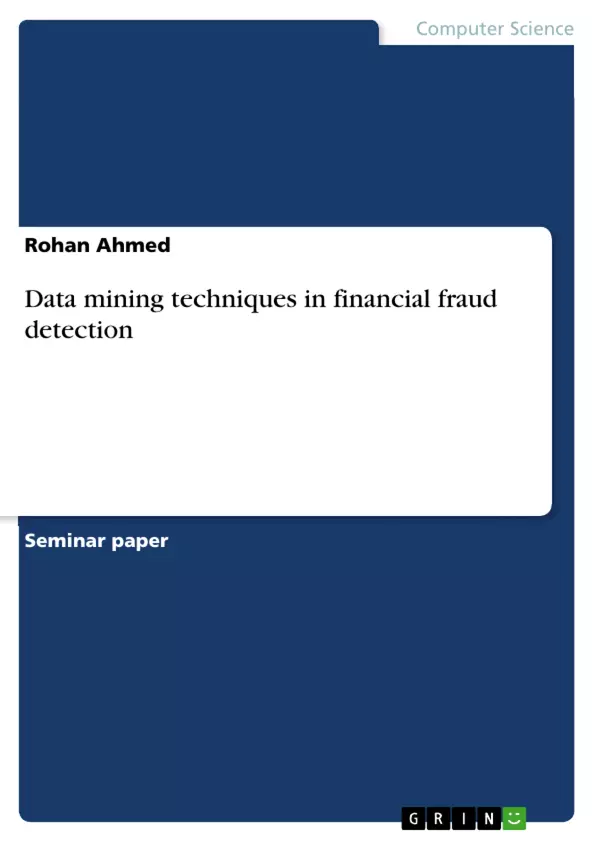In this seminar thesis you will get a view about the Data Mining techniques in financial fraud detection. Financial Fraud is taking a big issue in economical problem, which is still growing. So there is a big interest to detect fraud, but by large amounts of data, this is difficult. Therefore, many data mining techniques are repeatedly used to detect frauds in fraudulent activities. Majority of fraud area are Insurance, Banking, Health and Financial Statement Fraud. The most widely used data mining techniques are Support Vector Machines (SVM), Decision Trees (DT), Logistic Regression (LR), Naives Bayes, Bayesian Belief Network, Classification and Regression Tree (CART) etc. These techniques existed for many years and are used repeatedly to develop a fraud detection system or for analyze frauds.
Table of Contents
- Introduction
- Goals
- Structure of seminar thesis
- Terminology
- Data Mining
- Fraud
- Financial Fraud
- Insurance Fraud
- Bank Fraud
- Research methodology
- Classification of Data Mining Applications
- Literature Review
- Conclusion
Objectives and Key Themes
This seminar thesis aims to analyze the literature on Data Mining techniques for financial fraud detection, focusing on the areas of Insurance, Health, Banking, and Financial Statement Fraud. The thesis explores the challenges of identifying and preventing fraudulent activities within these sectors, where the vast amount of data makes detection difficult. The study investigates the application of various Data Mining techniques in tackling financial fraud.
- Data Mining techniques for fraud detection
- Financial fraud detection in different sectors (Insurance, Health, Banking, Financial Statement Fraud)
- Challenges of fraud detection in large datasets
- Applications of common Data Mining techniques (Support Vector Machines, Decision Trees, Logistic Regression, Naives Bayes, Bayesian Belief Network, Classification and Regression Tree)
- The evolution and effectiveness of Data Mining techniques in fraud detection
Chapter Summaries
- Introduction: The introduction provides an overview of the rising problem of financial fraud and the importance of data mining techniques in its detection. It outlines the main goals and structure of the seminar thesis, emphasizing the focus on insurance, health, banking, and financial statement fraud.
- Terminology: This chapter defines key terms such as Data Mining, Fraud, Financial Fraud, Insurance Fraud, and Bank Fraud. It explores various definitions and classifications of these terms, providing a foundation for understanding the concepts related to fraud detection.
- Research methodology: This chapter explains the methodology used in this literature review. It details the keywords used for searching relevant literature and the specific online databases (Google Scholar, ScienceDirect, and Springer Link) that were utilized. The search criteria are clearly outlined, including the time period of publications and the focus on articles that demonstrate the application of data mining techniques in fraud detection.
- Classification of Data Mining Applications: This section delves into the various applications of data mining techniques in different fraud detection areas. It highlights the specific techniques used for each area and examines their effectiveness in identifying and preventing fraudulent activities.
Keywords
This research focuses on data mining techniques in financial statement fraud, particularly within the domains of insurance, health, banking, and financial statement fraud. The study explores various techniques such as Support Vector Machines (SVM), Decision Trees (DT), Logistic Regression (LR), Naives Bayes, Bayesian Belief Network, and Classification and Regression Tree (CART). These techniques are applied to analyze large datasets and identify patterns associated with fraudulent activities.
- Arbeit zitieren
- Rohan Ahmed (Autor:in), 2016, Data mining techniques in financial fraud detection, München, GRIN Verlag, https://www.grin.com/document/426829



